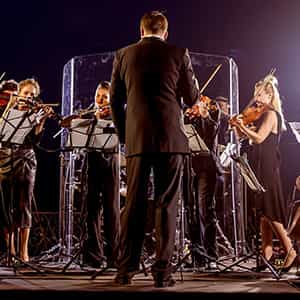

Shostakovich Symphony No. 11 Tickets
No Buyer Fees on Shostakovich Symphony No. 11 Tickets and Up to 30% Off Compared to Competitors. Learn More →
Select Location (e.g, New York)
Events Nearby
- Nov 28, 2025FRI•07:00 PMNov28fri07:00 PM - Vancouver Symphony Orchestra: Joshua Weilerstein - Mozart & Shostakovich 11Orpheum Theatre - Vancouver, Vancouver, CA
- Nov 30, 2025SUN•03:00 PMNov30sun03:00 PM - Vancouver Symphony Orchestra: Joshua Weilerstein - Mozart & Shostakovich 11Orpheum Theatre - Vancouver, Vancouver, CA
Frequently Asked Questions About Shostakovich Symphony No. 11 Tickets and Events
What is the significance of Shostakovich's Symphony No. 11 in the context of classical music?
Shostakovich's Symphony No. 11, also known as the 'Year 1905,' is significant as it reflects the political and social turmoil of Russia during the 1905 revolution. It is often interpreted as a commentary on oppression and the struggle for freedom.
What themes are explored in Shostakovich's Symphony No. 11?
The themes of Shostakovich's Symphony No. 11 revolve around revolution, suffering, and the fight against tyranny. The symphony portrays the experiences of the oppressed and the hope for liberation.
How does Shostakovich's Symphony No. 11 compare to his other symphonies?
Compared to his other symphonies, Symphony No. 11 is more programmatic and politically charged. It showcases his ability to convey deep emotion and narrative through orchestral music, making it distinct in his body of work.
What instrumentation is used in Shostakovich's Symphony No. 11?
Shostakovich's Symphony No. 11 is scored for a large orchestra, including strings, woodwinds, brass, percussion, and a large battery of instruments that contribute to its powerful and dramatic sound.
What is the historical context surrounding the composition of Symphony No. 11?
Symphony No. 11 was composed in 1957, during a time of relative thaw in Soviet cultural policies following Stalin's death. It reflects Shostakovich's response to the memories of the 1905 revolution and the ongoing struggles in Soviet society.
What are some notable performances or recordings of Shostakovich's Symphony No. 11?
Notable performances of Symphony No. 11 include those conducted by Leonard Bernstein and Valery Gergiev, among others. Various acclaimed orchestras have also recorded the symphony, each bringing their unique interpretation to the work.
How is the structure of Shostakovich's Symphony No. 11 organized?
Symphony No. 11 is structured in four movements, each depicting different aspects of the 1905 revolution, with a narrative arc that builds tension and culminates in a climactic finale.
What emotions does Shostakovich aim to evoke in listeners through Symphony No. 11?
Through Symphony No. 11, Shostakovich aims to evoke a range of emotions, including sorrow, anger, and ultimately a sense of hope and resilience in the face of oppression.
How has Shostakovich's Symphony No. 11 influenced contemporary composers?
Shostakovich's Symphony No. 11 has influenced contemporary composers by demonstrating how music can serve as a powerful vehicle for social commentary and emotional expression, inspiring new generations to explore similar themes in their works.
What is the overall reception of Shostakovich's Symphony No. 11 among critics and audiences?
The overall reception of Symphony No. 11 has been largely positive, with critics praising its emotional depth and historical significance. Audiences often find it compelling due to its dramatic narrative and powerful orchestration.

